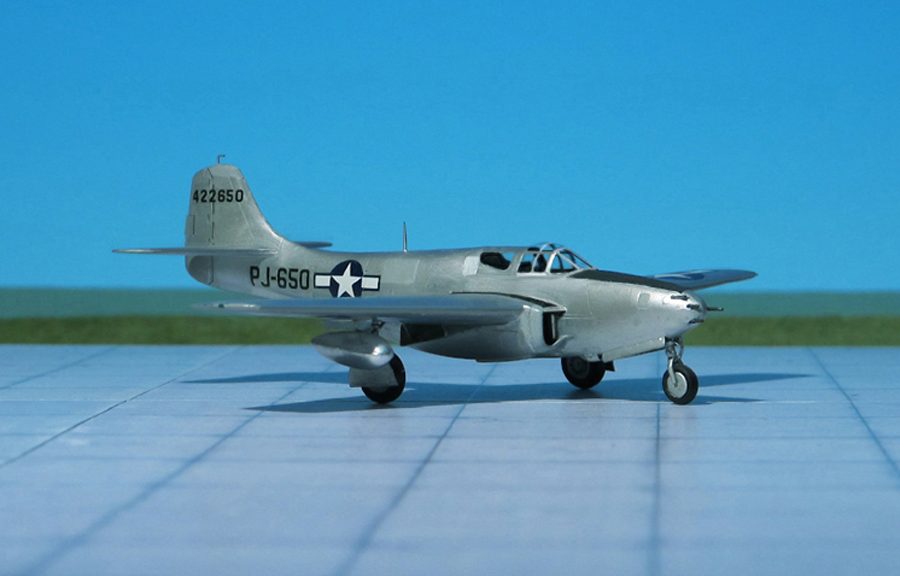TYPE: Fighter
ACCOMMODATION: Pilot only
POWER PLANT: Two General Electric J31-GE-5 turbojet engines, rated at 750 kp each
PERFORMANCE: 413 mph at 30,000 ft
COMMENT: The Bell P-59 “Airacomet” was a twin turbojet-engine fighter aircraft, the first produced in the United States, designed and built by Bell Aircraft Corporation during WW II. The United States Army Air Force was not impressed by its performance and cancelled the contract when fewer than half of the aircraft ordered had been produced. Although no P-59s entered combat, the fighter paved the way for another design generation of U.S. turbojet-powered aircraft, and was the first turbojet fighter to have its turbojet engine and air inlet nacelles integrated within the main fuselage.
Major General H. H. “Hap” Arnold became aware of the United Kingdom’s turbojet program when he attended a demonstration of the Gloster E.28/39 in April 1941. He requested, and was given, the plans for the aircraft’s powerplant, the Power Jets W.1, which he took back to the U.S. He also arranged for an example of the engine, the Whittle W.1X turbojet, to be flown to the U.S in October 1941 in the bomb bay of a USAAF Consolidated B-24 “Liberator” along with drawings for the more powerful W.2B/23 engine and a small team of Power Jets engineers. On 4 September, he offered the U.S. company General Electric a contract to produce an American version of the engine, which subsequently became the General Electric I-A. On the following day, he approached L. D. Bell, head of Bell Aircraft Corporation, to build a fighter to utilize it. Bell agreed and set to work on producing three prototypes. As a disinformation tactic, the USAAF gave the project the designation “P-59A”, to suggest it was a development of the unrelated Bell XP-59 fighter project which had been canceled. The design was finalized in January 1942, and construction began. In March, long before the prototypes were completed, an order for 13 “YP-59A” preproduction machines was added to the contract.
In September 1942, the first XP-59A was sent to Muroc Army Air Field in California by train for testing. While being handled on the ground, the aircraft was fitted with a dummy propeller to disguise its true nature. The aircraft first became airborne during high-speed taxiing tests on October although the first official flight one day later. A handful of the first “Airacomets” had open-air flight observer later cut into the nose; over the following months, tests on the three XP-59As revealed a multitude of problems including poor engine response and reliability – common shortcomings of all early turbojets – , insufficient lateral stability, i.e., in the roll axis, and performance that was far below expectations. Chuck Yaeger flew the aircraft and was dissatisfied with its speed, but was amazed at its smooth flying characteristics. Nevertheless, even before delivery of the YP-59As in June 1943, the USAAF ordered 80 production machines, designated P-59A “Airacomet”.
The 13 service test YP-59As had a more powerful engine than their predecessor, the General Electric J 31, but the improvement in performance was negligible, with top speed increased by only 5 mph and a reduction in the time they could be used before an overhaul was needed. One of these aircraft, the third YP-59A was supplied to the Royal Air Force, in exchange for the first production Gloster “Meteor”. British pilots found that the aircraft compared very unfavorably with the turbojets that they were already flying. Two YP-59A “Airacomets” were also delivered to the U.S. Navy where they were evaluated as the YF2L-1 but were quickly found completely unsuitable for carrier operations.
Faced with their own ongoing difficulties, Bell eventually completed 50 production “Airacomets”, 20 P-59As and 30 P-59Bs; deliveries of P-59As took place in the fall of 1944. Each was armed with one 37 mm M4 cannon and 44 rounds of ammunition and three 12.7 mm machine guns with 200 rounds per gun. The P-59Bs were assigned to the 412th Fighter Group to familiarize USAAF pilots with the handling and performance characteristics of jet aircraft. While the P-59 was not a great success, the type did give the USAAF experience with the operation of jet aircraft, in preparation for the more advanced types such as the Lockheed P-80 “Shooting Star” that would shortly become available. Nevertheless, early in 1944 Bell designers began the development of a turbojet powered fighter of similar configuration as the P-59 “Airacomet” but improved performance, the Bell XP-83. But the performance was somewhat disappointing, too, and the project was cancelled, only two prototypes were built (Ref.: 8, 24).












